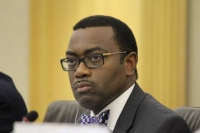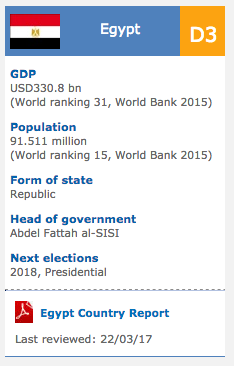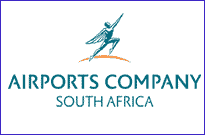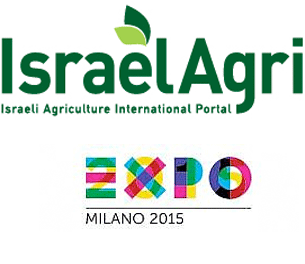Rwanda: Rwanda Outlook for 2015-16
2013/10/10

The country (Rwanda) is situated in Central Africa, east of Democratic Republic of the Congo. It has borders with Burundi for 290km, Congo (Kinshasa) for 217km, Tanzania for 217km and Uganda for 169km.
Land in Rwanda is mostly grassy uplands and hills; relief is mountainous with altitude declining from west to east.The climate is temperate rainy seasons (February to April, November to January); mild in mountains with frost and snow possible.
Outlook for 2015
In 2013, temporary aid suspensions had significant economic repercussions for Rwanda. On the positive side, this triggered Rwanda to search for ways to reduce its aid dependency.
Strengths (+) and weaknesses (-)
(+) Good business climate
Reforms carried out since 2000 transformed Rwanda into a country with an attractive business environment, as indicated by high rankings on international business indicators (e.g. ranked 32nd globally and 2nd in Sub Sahara Africa on the World Bank’s Ease of Doing Business indicator).
(-) High risk of social upheaval
Simmering ethnic tensions between the minority, but ruling, Tutsis and the majority Hutus could burst into violence again in the future. On top of that, the president’s repression of the opposition and dissidents also causes tensions that could spark into social unrest.
(-) Aid dependence
Donor aid represents an important source of financing for the Rwandan public budget. On average, assistance accounts for 30-40% of public expenditure.
(-) Narrow economic base
Being a landlocked, primary commodities exporter, whose economy is focused on agriculture (32% of GDP and 80% of employment), Rwanda has a narrow economic base.
Key developments
1. Conflict with DR Congo - is the end in sight?
The presence of Hutu insurgent groups in the resource-rich eastern DR Congo triggered Rwanda to become closely involved in the long lasting armed conflict there, sparking tensions between the two neighbouring countries. After an intensification in 2012-2013, tensioned ebbed at the end of 2013, when the M23 rebel movement gave up arms and signed an agreement with the Congolese authorities. This reduces the probability of a conflict between Rwanda and DR Congo significantly. Moreover, the fact that Congolese and UN security forces also launched an operation against the FDLR, a rebel group operating from DR Congo against the Rwandan government, further eased the tensions between the two neighbours. UN accusations of Rwanda supporting the M23 rebels in neighbouring DR Congo had led to substantial donor aid cuts in late 2012. Assistance was resumed in 13H2, after 11 countries (including Rwanda) signed a UN mediated peace agreement in February 2013. But tensions returned in August, when Rwanda threatened to intervene in the east of DR Congo after a cross-border shelling episode. The situation seemed to further worsen in October, when the United States cut military aid once again due to Rwanda’s alleged complicity in the use of child soldiers in DR Congo. Fortunately, a two week military campaign by the Congolese army (FARDC), backed by UN forces, was a game changer. The M23 rebels were defeated and they signed an agreement with the Congolese authorities in December 2013. While tension has decreased, stability in DR Congo remains fragile.
2. The economic fallout of donor aid cuts
Despite reinstatement in 13H2, the donor aid cuts of late 2012 had significant economic repercussions, revealing Rwanda’s susceptibility to it. The surrender of the M23 rebels in DR Congo reduces the risk of such cuts in the future. However, the risk can re-emerge, because President Kagame’s increasingly authoritarian practices, such as recent assassinations of dissidents in exile, allegedly committed by the Rwandan secret services, could once again strain relationships with the West. A direct impact of the decrease in grants was a drop in public revenues, causing the budget deficit to soar from 1.2% of GDP in 2012, to 4.6% of GDP in 2013. The budget deficit is projected to narrow only marginally in coming years. The low level of public debt, 24% of GDP in 2013, provides comfort. But forecasts point towards a sharp rise (up to 28% of GDP in 2015), and that could become a concern. Lower donor support did have a positive effect too, as it triggered the authorities to focus on increasing self-reliance. Progress was already visible in 13Q3, when domestic revenues saw a 14% yoy increase, among others, due to new measures such as a royalty tax on minerals. Another consequence of the aid cuts was a slowdown in economic growth, which dropped from 8% in 2012 to 6.5% in 2013 on the back of tighter fiscal policy, especially due to lower capital expenditure. Looking forward, economic growth is forecast to be robust at above 7% in the coming years, supported by developments in infrastructure, agriculture and communications. Lastly, the reduced assistance affected the current account balance. The impact was already visible in 2012, when the current account deficit deteriorated by 54%, to 11.6% of GDP. In 2013 it remained high, 11.4% of GDP, as the main components, trade and transfers, were fairly stagnant.
 Source: EIU
Source: EIU Source: EIU
Source: EIU3. Maiden international bond issue - higher debt risk, but also higher degree of independence
In recent years, many African sovereigns tapped into the international markets as abundant liquidity in advanced economies allowed for cheap funding. So did Rwanda. The debt issue changed Rwanda’s debt risk profile, but it also reduced its dependency on aid. On 25 April 2013, Rwanda issued a USD 400m (6% of GDP) maiden international bond. Orders for the 10-year bond totalled USD 3bn, driving the yield down to a low 6.875%. Rwanda had been planning a sovereign bond debut for years, but the fall in donor assistance seems to have precipitated the move, as budget pressures mounted. The issue pushed the share of commercially financed external public debt from 0% to 24%. However, the low level of external debt, 22% of GDP in 2013, provides comfort.
4. Regional integration advances are supportive of Rwandan economic potential
In 2013, the East African Community[1] (EAC), and the ‘coalition of the willing’ (Rwanda, Kenya and Uganda) in particular, achieved greater regional integration, which improves Rwanda’s access to neighbouring markets. Considering the small size of the Rwandan economy in comparison to these markets (more than 80mln people and more than USD 80bn in economic activity), such access can give a substantial boost to Rwanda’s economic potential. The EAC signed a protocol for the implementation of a monetary union by 2024 and agreed to start a customs union in January 2014 (fully operational in July). On top of that, the ‘coalition of the willing’ agreed on introducing a single tourist visa, eliminated non-tariff barriers and reached agreements on joint infrastructural projects, including railways and oil pipelines.
[1] The East African Community (EAC) is a regional intergovernmental organisation between Burundi, Kenya, Rwanda, Tanzania and Uganda having as objectives the implementation of a customs union, of a common market and of a monetary union.
 Source: EIU, CIA World Factbook, UN, World Economic Forum, Transparency International, Reporters Without Borders, World Bank.
Source: EIU, CIA World Factbook, UN, World Economic Forum, Transparency International, Reporters Without Borders, World Bank.Background information
Rwanda is a small, landlocked country in Eastern Africa and the most densely populated nation on the continent. Despite remarkable progress on improving human development in the past decade, poverty is still widespread. The country’s main exports are agricultural commodities, especially tea and coffee (27% of exports). Despite the importance of agriculture for the economy, the country is a net food importer. The ICT sector is fairly developed for African standards (64% of the population has a mobile phone subscription), as the sector enjoys broad government support. For example, the government introduced public Wi-Fi hotspots in the capital in 2013. The share of exports destined for Africa and Developing Asia, accounting for 43% and 29% of exports in 2007-2011, respectively, has increased significantly in the past decade, at the expense of Europe, which saw its share drop from 65% of exports in 1996-2000 to 20% in 2007-2011. Rwanda’s main trading partner is Kenya, which reflects the country’s dependence on its neighbour for logistics.
Ever since gaining independence from Belgium in 1961, Rwanda’s history has been characterized by ethnical tensions between the Tutsis and the Hutus. The conflict culminated in genocide in 1994, when 800,000 people were killed (20% of the population) within 100 days. Ever since, the political scene has been dominated by the Rwandan Patriotic Front, a Tutsi-dominated party, previously a rebel group. Following a transition period, Rwanda became a multiparty democracy in 2003. However, President Kagame’s suppression of opposition and dissent renders it a de facto dictatorship. The low ranking on the Press Freedom Index is an illustration of this. Internationally, progress on reducing corruption and poverty has built good relations with donors, especially the USA and UK.
 Source: EIU
Source: EIU- Related Articles

Kagame to ‘Post’: Israel helping Rwanda defeat jihadist threats
2017/07/14 Kagame’s relationship with Israel extends back to 1994, at the same time as he was instrumental in putting an end to the genocide there that killed an estimated one million people. Israel has enhanced Rwanda’s security capacity to transaction with terrorist threats coming from jihadist groups both from the Horn of Africa and the western part of the continent, Rwanda’s President Paul Kagame told The Jerusalem Post on Monday.
Africa's Relationship With China Is Ancient History
2017/07/02 In 2002 South Africa's Parliament unveiled a digital reproduction of a map - of China, the Middle East and Africa - that some speculated could be the initial map of the African continent. The Da Ming Hun Yi Tu - the Comprehensive Map of the Great Ming Empire - was drawn up around 1389 during the Ming Dynasty, according to historian Hyunhee Park.
Africa: Making Things Happen at the Bank - 'Not a Talk Shop' - Akin Adesina
2017/07/02 Dr. Akinwumi Adesina is focusing on five areas to achieve the African and world goals for a prosperous continent since becoming president of the African Development Bank - Africa's major public financial institution in September 2015. He was a keynote speaker at this month's Corporate Council on Africa's U.S.- Africa Business Summit in Washington D.C. and moderated a lively panel with five African government ministers. He as well received the Gene White Lifetime Succcess Award from the World Child Nutrition Foundation. This week, he was named the 2017 recipient of the World Food Prize, a prestigious honor that includes a $250,000 award. In an interview in Washington, DC, Adesina discussed the Development Bank's ambitious schedule and his vision for attracting the increase capital Africa needs. Posting questions for AllAfrica was Noluthando Crockett-Ntonga.
Climate change laws around the world
2017/05/14 There has been a 20-fold increase in the number of global climate change laws since 1997, according to the most comprehensive database of relevant policy and legislation. The database, produced by the Grantham Research Institute on Climate Change and the Environment and the Sabin Center on Climate Change Law, includes more than 1,200 relevant policies across 164 countries, which account for 95% of global greenhouse gas emissions.
Roko Construction Ltd Roko builds up Rwanda’s skills & skylines
2016/12/10 Regionally renowned for quality and timely construction and its local training and staff development programs, Roko Construction is open to further expansion and partnerships. Director Derek Claassen assesses Rwanda’s ongoing infrastructure building efforts, some of the bottlenecks to better regional integration, the advantages of Roko having its own materials manufacturing plants, its extensive in-home skill sets, and its signature building projects making their mark on Rwanda’s infrastructure and human resource pool.
- Rwanda News
-
- RWANDA: Rwandan police arrest Diane Rwigara, family members
- BOTSWANA: Africa: USA-Africa - No Policy? Bad Policy? or Both?
- BOTSWANA: Africa: U.S. State Department To Get Experienced Diplomat in Key Africa Post
- BOTSWANA: Africa’s economic growth in 2016 was driven by East Africa
- BOTSWANA: Africa property offers rich pickings for the brave
- BOTSWANA: Bill Gates sees US likely to maintain aid levels for Africa
- Trending Articles
-
- BOTSWANA: Africa: U.S. State Department To Get Experienced Diplomat in Key Africa Post
- BAHRAIN: Bahrain inks deal to develop solar power policies
- NORTH KOREA: Mexico expels North Korean ambassador over nuclear tests
- BRAZIL: Ex-minister accuses former Brazil President Lula of accepting bribes
- CHINA: China e-car venture Future Mobility names brand Byton, eyes U.S., Europe
- UNITED ARAB EMIRATES: Emirates Academy of Hospitality ranked among world’s top 10












